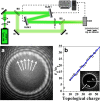Zeroth- and first-order long range non-diffracting Gauss-Bessel beams generated by annihilating multiple-charged optical vortices
- PMID: 33319796
- PMCID: PMC7738530
- DOI: 10.1038/s41598-020-78613-7
Zeroth- and first-order long range non-diffracting Gauss-Bessel beams generated by annihilating multiple-charged optical vortices
Abstract
We demonstrate an alternative approach for generating zeroth- and first-order long range non-diffracting Gauss-Bessel beams (GBBs). Starting from a Gaussian beam, the key point is the creation of a bright ring-shaped beam with a large radius-to-width ratio, which is subsequently Fourier-transformed by a thin lens. The phase profile required for creating zeroth-order GBBs is flat and helical for first-order GBBs with unit topological charge (TC). Both the ring-shaped beam and the required phase profile can be realized by creating highly charged optical vortices by a spatial light modulator and annihilating them by using a second modulator of the same type. The generated long-range GBBs are proven to have negligible transverse evolution up to 2 m and can be regarded as non-diffracting. The influences of the charge state of the TCs, the propagation distance behind the focusing lens, and the GBB profiles on the relative intensities of the peak/rings are discussed. The method is much more efficient as compared to this using annular slits in the back focal plane of lenses. Moreover, at large propagation distances the quality of the generated GBBs significantly surpasses this of GBBs created by low angle axicons. The developed analytical model reproduces the experimental data. The presented method is flexible, easily realizable by using a spatial light modulator, does not require any special optical elements and, thus, is accessible in many laboratories.
Conflict of interest statement
The authors declare no competing interests.
Figures










References
-
- Durnin, J. Exact solutions for nondiffracting beams. I. The scalar theory. J. Opt. Soc. Am. A4, 651–654 (1987).
-
- Bouchal Z. Nondiffracting optical beams: Physical properties, experiments, and applications. Czech. J. Phys. 2003;53:537–578. doi: 10.1023/A:1024802801048. - DOI
-
- McGloin D, Dholakia K. Bessel beams: Diffraction in a new light. Contemp. Phys. 2005;46:15–28. doi: 10.1080/0010751042000275259. - DOI
LinkOut - more resources
Full Text Sources

